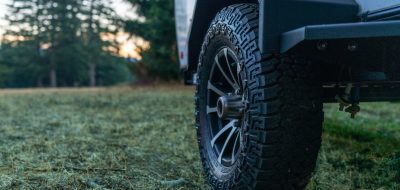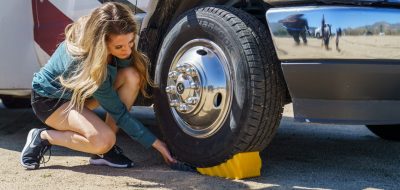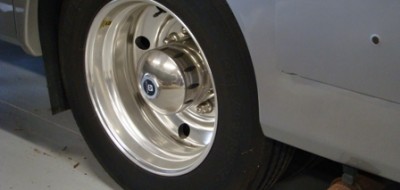Well sir, I have never been accused of being terribly smart and politicaly astue, so here I go jumping from the frying pan into the fire on a subject that some have said in the forums is a dead horse and beaten to death. But there is more to the tire pressure story than just when will it fail or blow up. Or how much pressure to ad and when.
We all know that a tire that is under inflated will use more power to make it roll than a properly inflated tire. That is because of these factors:
- The tire is presenting a larger foot print on the ground increasing the rolling resistance.
- The distance from the steel or aluminum wheel to the tread is less on the bottom than on the top meaning that the wheel is constantly climbing up hill on the tire. The cords in a radial tire under the tread are wrapped around the tire like a bulldozer tread.
- The side wall flexes more with less tire pressure meaning that the cords in the tire are constantly rubbing together creating heat from friction. The side wall cords are wrapped from one bead of the tire up and over the tread.
OK, it is true that heat will increase the air pressure inside a tire but that is proportional and you will not make up the under iflation difference with that heat build up. But that heat build up can be enough to start to make the tires various parts loose their bond with each other. That is evidenced by the sightings of long strips of tread rubber beside the highway. They lost their bond and flew off. By the way all tires, new or recaps, are the same as the tread is laid on and vulcanized to the body of the tire called the carcass. The only difference is that the new tire the tread is vulcanized to new material and on the recap it is vulcanized to an old surface that has been ground down.
Proper tire inflation for the weight being carried means that the tire will flex within the design limits established by the tire engineer. This is the weight at so many pounds per square inch of pressure listed on the side wall. The engineer says to us that this tire will not flex it’s side walls exsessively at this ratio. He is also telling us that the tread pattern on the ground will be within acceptable size limits at these limits.
Under inflation is not only a problem when considering heat build up but can effect tire wear and wet driving traction. When a tire is under inflated the center part of the tread tends to be pushed up inside of itself causing more of the load of the tire to be borne on the shoulders of the tire. This will wear the two outer edges of the tread well before the center of the tread wears. In doing this the tread pattern is distorted and the gaps in the tread squeeze together. It is the gaps in the tread that provides an escape route for water on the road surface when it is raining. Under inflated tires will hydroplane, lift off the pavement and float on the surface of the water, at lower speeds than properly inflated tires.
Yes I know, the old “lower the air pressure when driving on sand” theme and that works because on sand you are not looking for traction you are looking to get the largest footprint on the sand to float the vehicle that you can. However the old lower the air pressure on snow has the opposite effect as it closes up all the nice biting surfaces of the tire tread that provides traction.
Over inflation can be seen in tire wear as the tread tends to wear more in the middle as the tire is ballooned out. Now with all of that said you are going to have wait until next week to see what I have to say about how to figure out the correct or recommended pressure, how tire pressure effects handling, and ride. I’ll be waiting for your comments.





Pingback: ניסור בטון
jimnlin
hmmm, much depends on what type of vehicle and tire type. All my experience is with truck and trailer combos. Having five different size flatbed/enclosed trailers and three trucks on the road simultaneously pulling these trailers has show me that using less than max pressures will shorten tire life and reliability. A trailers needs/reasons for max pressures are different than the tow vehicle. Goodyear web says it best ;
RV TRAILER TIRES
“Unless trying to resolve poor ride quality problems with an RV trailer, it is recommended that trailer tires be inflated to the pressure indicated on the sidewall of the tire. Trailer tires experience significant lateral (side-to-side) loads due to vehicle sway from uneven roads or passing vehicles. Using the inflation pressure engraved on the sidewall will provide optimum load carrying capacity and minimize heat build-up.”
Much of our reload trips were running empty and never had a center worn prob on any of those trailers in the eight years I had the operation.
Michelin truck tire says “max performance and max reliability come at max sidewall pressures”. Thats just another reason a properly matched tire at max pressures to the trailers GAWR’s or the truck operating at max axle loads, will run cooler/last longer/less prone to road hazard damage than a tire run at lower pressures. Commercial haulers number one sin is letting a trailer tire drop under max sidewall pressures as we run close to max axle loads. Same for the trucks rear axle. The trucks front axle may or may not need max tire pressures as it depends on how far forward of the rear axle the pin/ball is set up.
I do air the truck tires down to a good foot print if its a few days before hauling again but the trailers stay at max.
I was lucky to have a tire dealer that had many customers that hauled for a living. He sure saved me lots of down time which = money when it came to what manufactures recommendation worked and what didn’t. To bad Ford didn’t listen to many tire dealers and even customers warning of underinflated tire pressures recommendations on the Ford Explorer………Jim
Bob McCrady
Another tire related question…..I read a recommendation that RV’s be stored with a vapor barrier such as heavy plastic sheets under the tires. I understand covering the tires to avoid UV damage, but why park on a vapor barrier?
Roger
Patrick,
Good question with no correct answer. It is a little like asking at what time did your milk go bad?
“It Depends” is the real answer but many think that is a cop out.
Here are some facts that may help you understand the complex variables that can affect when a tire should be replaced.
First the general age. Most tire companies suggest 6 to 10 years as a maximum for a general guideline based on no damage, punctures overloading or underinflation ever occured.
You can determine the “birth date” of your tires by reading the last 4 digits of the DOT serial. All tires have a DOT serial that is usually 10 to 12 letters and number molded into a tire right after the capitol letters DOT.
The last 3 numbers (last 4 since about March 2001) are the date code.
2304 would be 23rd week 2004
5201 would be 52nd week 2001
1349 would be an older 3 digit date 34th week 1999
If the last digit is a 2 through 8 is is probably from 2002 through 2008
If you have the last digit of 9 it is most likely 1999
If the last is 1 or 0 then you need to do some more investigation. Is it 2001 or 1991 or 2000 or 1990. If you bought the RV new or have replaced the tires you probably have a good idea of the birth date.
Now as to how old is OK
One significant factor is the time at a temperature. Tires “age” at a faster rate at higher temperature. It is not linear.
If you figure that at 70°F a tire ages at 1 year per year at 70°F you might consider that your baseline.
For every day at 80°F it is like 2 days at 70°
For every day at 90° it is like 2 days at 80° etc
Basically a tire age rate doubles every 10° is a reasonable approximation.
Also when you are driving the tire is operating at about 15 to 35° hotter than ambient so it is aging faster when you are driving.
Now lets add in underinflation which results in a higher operating temperature maybe 50 to 100° above ambient
Also even if you are at the max inflation on the sidewall but you overload the tire beyond it’s listed capacity you can overheat a tire by 20 to 100° depending on how much you are overloading it.
Other considerations. When you are parked; Is the tire in direct sunlight? This can raise that tire’s temperature by 20 to 50°
Are you parked in an area with high air polution or Ozone from electric motors or even a ozone generator used to kill mold.? That can also accelerate aging.
I have seen 3 sets of tires “killed” in one year by a person parking in a garage with an ozone generator in it. The tires were from 2 different manufacturers too.
Did you ever have a puncture? How far did you drive it at what level of underinfaltion? I have documented permanent structural damage occuring in as little as 3.9 miles at speeds as low as 10 to 20 mph.
Did you scrub off the built in protectants in a tire by using petrolium based cleaner or scowering pad?
I have listed approximations of some of the things that can affect a tire’s age. I think you can see why there is no simple answer but one thing to remember. Damage, wether done by time and temperature or by underinflation or overloading is cumulative and no tire repairs the damage done even if you re-inflate the tire.
Patrick Allen
Okay,
My thought is go by what the tire manufacturer prints on the side of the tire for Max. pressure. Now my question is the tires on my class-c are the original tires. I went to an RV repair facility the other day to have the coach serviced, oil change etc. etc. Ask them to rotate the tires like the local Ford dealer I take the RV to for chassis service does, the Rv repair shop said the tires were bad in need of replacement. (due to weather damage) they even refused to rotate the tires because they said they could blow out. They told me that they could get me a set of tires for the RV, at cost. So I stopped at the Truck tire shop by where I store my RV, the Truck tire dealer said there was nothing wrong with the tires. The tires even have a lot of tred still on them. So my question is when do the tires need to be replaced if they are over two years old.
Casey Balvert
Thanks to Brad and Roger for some valuable info as well as confirming my tire inflation practises. I use the load inflation tables and weight the rig every couple of years to determine the correct pressurres. I then add 5 psi as a safety factor. All my tires are load range E and I have it calculated at 65 psi for everything but the front tires on the tow vehicle which come out to 60 psi. All wheels except the TV front are duals. I addition I have a pressure monitor system and check temperatures at every stop. I used to use my hand. I found tires that run at proper inflation are quite confortable to place my hand on and I also look for differences between tires. I have found the inner dual tends to run a bit hotter probably due to decrease airflow over the tire. So far this has worked for me.
Roger Marble
Some comments on the original Blog by brad.
In general it contains some good observations but not everything is completely accurate.
Point 1 is correct.
Point 2 is an interesting concept but cord forces and tire defelction are much mor complex that this statement implies.
Point 3 The cords do not really rub together. A tire is really solid with the steel and polyester reinforcing materials completely encased with various different rubber compounds. The heat is generated by the flexing and bending of the rubber not cords rubbing together as you would rub two sticks together to start a fire.
The load is essentially carried by the inflation not the tire structure itself. There are industry standards published by organizations such as The Tire & Rim Association, that have charts and formulas for establishing the load capability of a tire of given dimensions. There are also tolerances for the actual dimensions of tires with the same “size” nominclature so a Goodyear, Michelin or Bridgestone LT235/75R16 of load range E all carry the identical load at 80 psi.
The “Old lower inflation on sand” is really old as it pertained to bias tires.
Bottom line.
1. Get your RV on a certified scale ASAP
2. Weigh each position – not just by axle
3. Based on your tire size and load range ( C, D, E or F) confirm the correct inflation needed for your tire size for the max load on the most heavly loaded position on the axle.
4. With a DIGITAL tire gauge be sure you have AT LEAST as much air as is required to carry the load.
Comment. I personally run 3 psi above the load calculations. I also have installed a Pressure monitor system on my new Class-C even though I check my inflation before each trip I can still get a puncture pulling out of my driveway and not know it till too late.
Roger Marble
I am a tire design engineer with 38 years experience. I teach tire failure analysis ( Think CSI for tires) so let me correct a few minor points and answer some of the questions.
The correct inflation is based on the actual load you are running. The inflation information in your owners manual is based on some assumptions on how much weight you are carrying. I have heard of some vehicles being only capable of adding 5oo# over their empty weight before the tire is overloaded so the only way for you to know the real answer is to get your vehicle weighed for each position. Then contact a tire dealer and ask if he has a load inflation chart. If he doesn’t find a different tire store. The correct inflation should be something below the max infl on the sidewall of the tire.
Only check your inflation when it is cold – not in the sun and not driven on for at
least 4 hours.
Inflation gauges – I have checked a number of different digital gauges and found them to be +/- 1 psi which is good enough for your purposes. I have bought digital gauges at a number of different locations ( Sears, AMAZON.com etc)
Air is already 80% Nitrogen. The fuel economy of a tire filled with air is the same as when filled with Nitrogen (really about 94% to 96%) when inflated to the same pressure. Nitrogen has some benefits but the cost may not be worth it..
Laser thermometers only show the surface temperature and you have less than a minute to take your measurement after leaving highway speeds before the temperature starts dropping off. The real problem is the temperature inside the tire structure which can only be measures with a special instrument. I would think you should not see any temperature over 150°F if things are correctly loaded & inflated.
More in next post.
Dan DeWinter
I use a laser thermometer and check my tires at each stop. Right now, I only look for a tire that is much hotter than the rest. I would like to know what is considered too hot.
Bob Brady
I pull a fiver , a Jayco 36RLTS, with 10 ply, 16 inch tires, load range E and have the same on a 250 Super duty Ford. All my tires have 80 lbs as per tire shop recomendations and sidewall stamped tire pressure. When uloaded I run 55 lbs in truck as this is pressure recomended on door post of truck. I also installed tire pressue sensors to monitor tire pressure after blowing two new tires on fiver last year.Checking tire pressure is a daily must when travelling, I have learned, whether tires are brand new or used for a season. I have heard positive comments about Nitrogen, and this will be my next move after learning more.
Gordon thompson
Unfortunately this post says little and answers less. In the spirit of being a contributor and not a critic, my answer would be Zero. I had my truck and trailer tires filled with an appropriate amount of Nitrogen. I recommend doing a Google search on Nitrogen in tires. The information will make the choice a “no brainer”.
Jerry Bertelsen
OK under inflated is not good. So where do I get an accurate tire gauge? Where do I find a air pump that will properly fill my tires?
Charles King
How do I unsubscribe from this blog?
Randy Arseneault
I keep 80 lbs in my 10 ply 16″ tires for hauling the fiver which is 12K lbs, but would like to know if it is hard on the tires to run at around 55 lbs when running empty?
Larry
The air limit for each tire is stamped on the side wall along with the carry wt. of the tire SW & DW.
Larry
Larry
I have been fulltiming for 8 years, I stop at Flying J’s with J-Scales about 2 times a year to weigh each axle of my rig. I use LT tires I am told they carry more wt. per tire size (than trailer tires) and have stronger side walls. This works for me.
Larry
Sven
The header says: How many pounds…?
That question was not answered at all! Was this a joke or what/